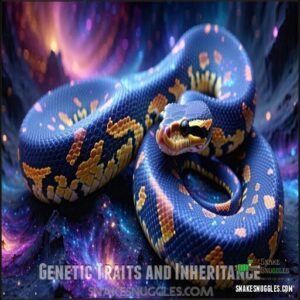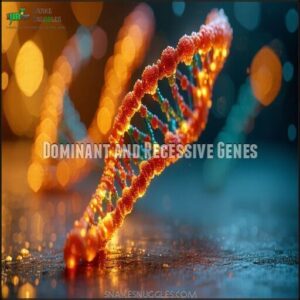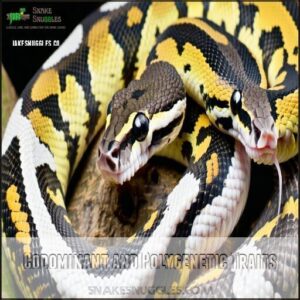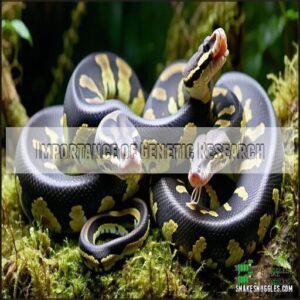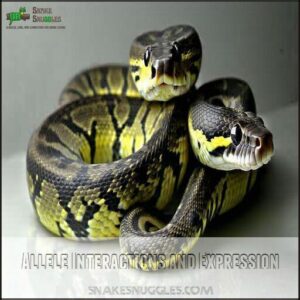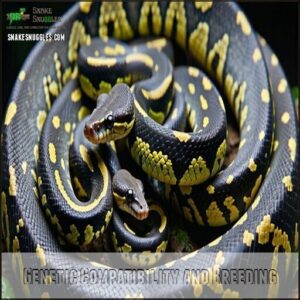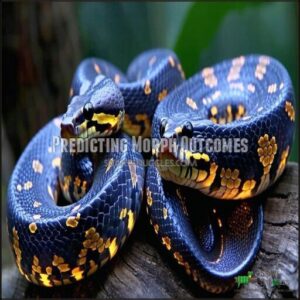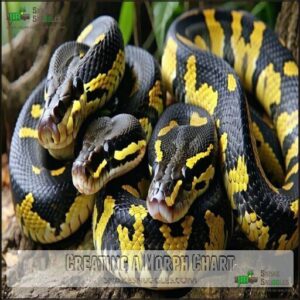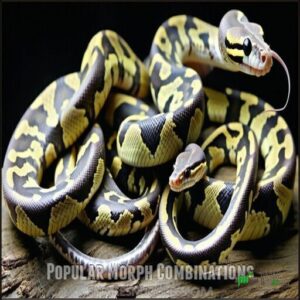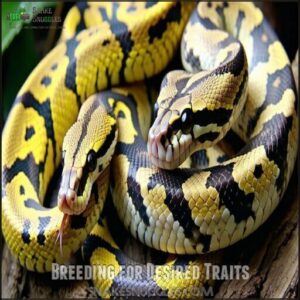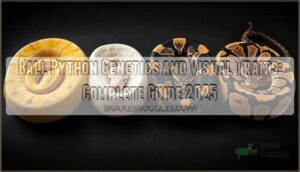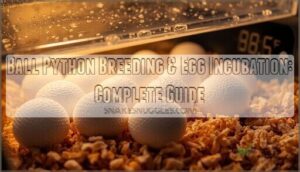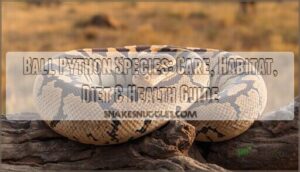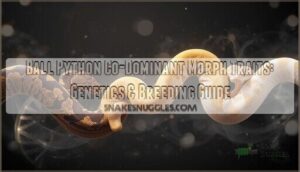This site is supported by our readers. We may earn a commission, at no cost to you, if you purchase through links.
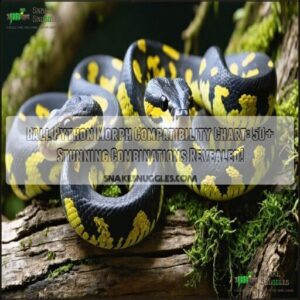 You’ll find a ball python morph compatibility chart essential for successful breeding projects.
You’ll find a ball python morph compatibility chart essential for successful breeding projects.
These charts map out how different genetic traits interact when paired together, helping you predict offspring appearances with confidence.
They typically organize morphs by inheritance patterns—dominant, recessive, co-dominant, and polygenic—showing which combinations create visual stunners and which might cause problems.
Think of it as your breeding roadmap that prevents costly genetic mistakes.
Whether you’re working with popular morphs like Spider or Banana, or experimenting with rarer combinations, a good compatibility chart guarantees healthier snakes with those eye-catching patterns collectors crave.
The genetic mysteries behind certain morph interactions might surprise you.
Table Of Contents
- Key Takeaways
- Ball Python Morph Basics
- Morph Compatibility Factors
- Creating a Morph Chart
- Popular Morph Combinations
- Breeding for Desired Traits
- Frequently Asked Questions (FAQs)
- What are ball python morphs?
- Are designer ball python morphs right for you?
- Which ball python morph is best?
- Do ball python morphs have genetic issues?
- How do you identify ball python morphs?
- How many types of ball python morphs are there?
- What happens if you put 2 female ball pythons together?
- What is the most sought after ball python morph?
- Which ball python morphs are dominant?
- Can you cross breed ball pythons?
- Conclusion
Key Takeaways
- You’ll need a morph compatibility chart to visualize genetic combinations and predict offspring outcomes, helping you prevent costly breeding mistakes and health issues like Spider wobble syndrome.
- Your breeding success depends on understanding inheritance patterns—dominant, recessive, co-dominant, and polygenic—which determine how traits express themselves in offspring.
- You can create stunning designer morphs worth $5,000+ by strategically combining compatible genetics, but always prioritize snake health and genetic diversity over appearance.
- You’ll make better breeding decisions when you categorize morphs by their genetic traits and document their interactions, allowing you to confidently predict which combinations will produce eye-catching patterns.
Ball Python Morph Basics
You’ll discover that ball python morphs are unique color and pattern variations created through selective breeding of naturally occurring genetic mutations, with over 4,000 distinct varieties categorized by dominant, recessive, or codominant traits.
When you understand these fundamental genetic principles, you can predict offspring outcomes and create stunning combinations that might range from common patterns worth under $100 to rare designer morphs valued at over $10,000, which can include designer morphs.
Genetic Traits and Inheritance
When breeding ball pythons, understanding genetic traits and inheritance patterns is your foundation for success.
These fascinating reptiles pass their distinctive characteristics through specific allele expressions and gene interactions.
Ball pythons pass their unique traits through intricate allele expressions, creating mesmerizing genetic patterns and captivating color variations.
- Snake genetics follow Mendelian principles, with traits passing from parents to offspring
- Ball python morphs result from natural mutations that affect color and pattern
- Inherited traits can be polygenetic, involving multiple genes working together
- Morph compatibility charts help visualize potential offspring outcomes
Some morphs, like the Spider morph, can cause neurological wobble syndrome.
Dominant and Recessive Genes
Now that you understand how genetic traits pass from parent to offspring, let’s look at the DNA blueprint that shapes your ball python’s appearance.
Dominant genes show their effects even when paired with a different gene.
You’ll see these traits with just one copy in your snake’s DNA. Recessive genes, however, need two copies to appear—that’s why some traits can "hide" for generations before suddenly showing up in offspring, which can be due to recessive genes and the fact that they need two copies to appear, making them hide for generations.
Codominant and Polygenetic Traits
Beyond simple dominant and recessive inheritance, ball pythons also show codominance, where both genes express themselves simultaneously.
You’ll notice incomplete dominance when traits blend together, creating unique visual variations.
Polygenetic traits involve multiple genes working together, making prediction more complex.
Your python morph compatibility chart should account for these trait interactions when planning breedings.
Complex combinations often yield the most stunning morphs, as genetic traits interact in fascinating, sometimes unpredictable ways, resulting in unique visual variations.
Importance of Genetic Research
Diving into genetic research before breeding ball pythons isn’t just important—it’s essential for both snake welfare and your success as a breeder.
Understanding trait inheritance and morph identification prevents unwanted genetic mutations.
- Research prevents health implications like "spider wobble" and other neurological issues
- Knowledge of ball python genetics helps predict offspring accurately
- Ethical breeding requires understanding compatibility charts
- Proper reptile genetics guides help avoid lethal combinations
These points highlight the importance of genetic research in ball python breeding, ensuring the health and well-being of the snakes, as well as the breeder’s success.
Morph Compatibility Factors
You’ll need to understand how different ball python genes interact with each other before creating those eye-catching designer morphs you’ve been dreaming about.
When you combine compatible genetic traits, you’re basically mixing colors on a living canvas, transforming ordinary pythons into extraordinary living works of art.
Allele Interactions and Expression
Now that you understand the basic genetic traits of ball pythons, let’s look at how these genes actually interact.
When two alleles meet, they don’t just politely take turns—they negotiate dominance. Gene dominance determines which traits show up in your snake’s appearance.
Co-dominance effects create unique blends, while recessive masking means some traits hide until paired with identical genes.
Polygenic influence explains why some morphs show varying degrees of expression across different allele combinations. Understanding dominant and recessive genes is essential for predicting offspring traits.
Genetic Compatibility and Breeding
While alleles determine trait expression, successful ball python breeding requires careful genetic compatibility analysis.
When pairing morphs, you’ll need to take into account how genes interact to avoid inbreeding risks and genetic anomalies.
A morph calculator can help track potential snake morph combinations.
Remember, ethical considerations should guide your reptile breeding approach—successful pairings balance mutation frequency and hybrid vigor to produce healthy, stunning offspring with predictable patterns.
Predicting Morph Outcomes
When mixing ball python morphs, you’ll need to understand genetic probabilities to anticipate outcomes.
Using a morph calculator helps predict visual expression patterns with reasonable accuracy. However, unexpected results occasionally happen due to trait amplification or hidden genetics.
Python morph breeding isn’t an exact science—some snake morph combinations present unique breeding challenges. You can also find a python morph calculator online.
The thrill of genetic prediction is discovering something beautiful yet unpredictable in your clutch!
Role of Breeders in Morph Development
Breeders’ expertise drives the entire python morph development process.
They’re the architects behind today’s stunning varieties through careful genetic selection and compatibility testing.
When considering python morph breeding, remember:
- Experienced breeders maintain genetic diversity while creating new morphs
- Health prioritization prevents harmful trait combinations
- Ethical concerns guide responsible breeding practices
- Documentation of snake morph genetics helps predict successful python morph combinations
The process involves careful consideration of several key factors, including genetic diversity, health, and ethical concerns, to ensure responsible breeding practices and predict successful python morph combinations.
Creating a Morph Chart
You’ll need a reliable morph chart to visualize genetic combinations and predict offspring outcomes when breeding ball pythons.
Creating your own compatibility chart helps you track dominant, recessive, and co-dominant traits, allowing you to plan breeding projects with confidence.
Categorizing Morphs by Genetic Traits
When you’re organizing ball python morphs, start by categorizing them according to their genetic traits. This creates a foundation for understanding python morph compatibility and breeding potential.
Genetic drift continuously introduces new morph variations.
| Trait Category | Key Characteristics | Common Examples |
|---|---|---|
| Dominant Morphs | Express with single gene | Spider, Pinstripe |
| Recessive Morphs | Require two copies | Albino, Piebald |
| Codominant Traits | Show unique Super form | Pastel, Enchi |
| Polygenic Inheritance | Multiple gene interactions | Ultramel, Champagne |
Identifying Dominant and Recessive Morphs
The puzzle pieces of genetic inheritance become clear when you learn to spot dominant and recessive morphs.
You’ll need this skill for accurate breeding outcomes.
Dominance identification relies on visual markers like pattern intensity and color.
| Inheritance Type | Examples | Expression |
|---|---|---|
| Dominant | Pinstripe, Spider | Shows with one gene copy |
| Recessive | Albino, Piebald | Requires two gene copies |
| Codominant | Pastel, Mojave | Shows differently with one or two copies |
The table illustrates how different types of inheritance are categorized, including recessive traits that require two gene copies to be expressed, and dominant traits that show with just one gene copy.
Charting Morph Interactions and Outcomes
Understanding a morph compatibility chart is like reading a roadmap to stunning snake combinations.
When you chart morph interactions and outcomes, you’ll need a visual representation that shows outcome probabilities clearly.
| Morph Combination | Compatibility Risks | Predicted Outcomes |
|---|---|---|
| Albino × Piebald | Low genetic issues | 100% Het carriers |
| Spider × Pastel | Wobble concerns | 25% Bumblebees |
| Mojave × Lesser | Very safe pairing | 25% Blue-Eyed Lucy |
Your breeding strategies improve when you see how python morphs interact on paper before actual breeding begins, allowing for clear understanding of the predicted outcomes.
Using The Chart for Breeding Decisions
Success in ball python breeding hinges on your ability to effectively use compatibility charts. These visual tools transform complex genetic probabilities into actionable breeding decisions.
The use of these charts can be seen in various breeding decisions, including pairing selection, investment planning, and long-term projects, which are crucial for ethical breeding practices.
| Breeding Decision | Chart Benefit | Ethical Consideration |
|---|---|---|
| Pairing Selection | Predicts visual outcomes | Avoids harmful combinations |
| Investment Planning | Estimates morph value | Prevents overbreeding |
| Long-term Projects | Maps genetic compatibility | Maintains genetic diversity |
For assistance, many breeders consult a python breeding chart, which helps in navigating python breeding genetics while maintaining ethical standards. With your chart in hand, you’ll confidently make informed decisions.
Popular Morph Combinations
You’ll discover stunning visual impacts when you combine compatible ball python morphs, creating snakes with extraordinary patterns and colors that simply weren’t possible with single-gene specimens.
From the striking contrast of Spider-Banana pairings to the ethereal beauty of Albino-Piebald combinations, these genetic masterpieces showcase nature’s flexibility when guided by careful breeding practices, resulting in extraordinary patterns.
Spider and Banana Morphs
Now that you’ve mastered chart creation, let’s explore two fascinating morphs that catch everyone’s eye. Spider and Banana morphs offer striking visuals but come with important considerations.
Spider morphs display beautiful patterns but can develop wobble syndrome, a neurological issue requiring ethical considerations.
When evaluating these morphs, remember:
- Monitor for head wobbles in Spider morphs
- Watch for unique freckles in Banana morphs as they age
- Research genetic compatibility before breeding these popular morphs
Albino and Piebald Morphs
While Spider and Banana morphs showcase dominant genetic traits, Albino and Piebald morphs reveal the beauty of recessive genes.
Both Albino genetics and Piebald patterns require two copies of recessive genes to appear.
Your python morph compatibility chart should note these visual variations can combine with other morphs, creating stunning breeding outcomes.
Albino morphs display bright yellow with red eyes, while Piebald morphs feature distinctive white patches with normal coloration, their rarity factors increasing their value.
Axanthic and Mystical Potion Morphs
How dramatically the sphere of Axanthic and Mystical Potion morphs can transform your ball python collection.
These recessive and designer morphs create stunning visual displays that captivate enthusiasts.
When exploring these morphs, remember:
- Axanthic variations remove yellow pigment, creating grayscale snakes
- Mystical Potion genetics combine Mojave and Mystic genes
- Visual identification shows purple, pink, and white patterns that fade to blue-grey with age
- Breeding challenges include 25% offspring success rates when pairing correctly
Rare and High-Value Morph Combinations
Many high-value morph combinations like the Bumblebee Ball Python (gravel and yellowbelly mix) and Banana Mimosa showcase exceptional visual appeal that drives their market value.
You’ll notice investment potential in GHI Clown combos, which are integral to accessing future breeding possibilities.
When using a snake morph calculator for genetic compatibility, consider both aesthetics and ethical concerns around genetic bottlenecks.
The Leopard Black Pastel Clown represents python breeding excellence, combining rarity with current market trends.
Breeding for Desired Traits
You’ll maximize your chances of producing stunning ball python offspring by carefully selecting parent snakes with complementary genetic traits based on our compatibility chart.
When you match morphs with the right genetic combinations, you’re not just breeding snakes but creating living works of art that showcase nature’s remarkable genetic possibilities, and by doing so, you are essentially creating living works of art.
Selective Breeding Techniques
Consistently, successful selective breeding techniques require understanding both science and art. You’ll need to master line breeding to strengthen desired traits while using outcrossing methods to prevent genetic bottlenecks.
Focus on trait fixation through careful parent selection—tracking which ball python morphs reliably pass specific patterns or colors.
Some breeders experiment with mutation induction, but ethical breeding practices emphasize snake health over appearance.
Many also purchase breeding supplies online for their projects.
Remember, reptile morph compatibility charts are your roadmap to predictable, stunning results.
Genetic Diversity and Health Considerations
While carefully selecting traits for your ball pythons, remember that genetic diversity is your friend.
Increased genetic diversity provides survival advantages and improves overall health in reptiles.
When planning breeding projects, watch for signs of inbreeding risks like smaller clutches or genetic defects.
Creating a genetic compatibility chart helps track bloodlines and prevent problems.
Hybrid vigor—the strength that comes from diverse genetics—can result in hardier snakes with better feeding responses and growth rates.
Maintaining proper temperature and humidity is essential for their well-being.
Ethical Breeding Practices
Beyond genetic diversity lies the heart of ethical breeding: prioritizing snake well-being above everything else.
In 2025, responsible breeding practices demand you make informed decisions that prevent suffering.
The debate around Spider morphs highlights your breeder responsibility. Understanding the ball python morphs is vital for responsible breeding.
When practicing ethical breeding, always consider:
- Avoiding morphs with documented neurological issues like the Spider wobble syndrome
- Supporting breeders who prioritize animal welfare over profit margins
- Maintaining detailed genetic records to prevent harmful combinations
- Using sustainable methods that guarantee proper care throughout the breeding process
Achieving Unique and Valuable Morphs
Diving into genetic innovation, you’ll discover that achieving unique and valuable ball python morphs requires strategic breeding.
By combining specific genetic traits, you can create stunning specimens that command high prices.
| Morph Combination | Rarity Level | Approximate Value |
|---|---|---|
| Albino + Piebald | Very High | $1,500-3,000 |
| Spider + Banana | Medium | $500-1,000 |
| Triple Recessive | Extremely Rare | $5,000+ |
| Designer Complex | Ultra Rare | $10,000+ |
Remember, ethical breeding practices should always guide your morph combinations, ensuring the creation of unique and valuable specimens.
Frequently Asked Questions (FAQs)
What are ball python morphs?
Like a painter’s palette of reptiles, ball python morphs are genetically distinct variations with unique colors and patterns.
You’ll find over 4,000 different morphs created through selective breeding of naturally occurring mutations.
Are designer ball python morphs right for you?
Designer ball python morphs require more knowledge, space, and money than standard varieties.
If you’re passionate about unique patterns and willing to invest in proper care, they might be perfect for your collection.
Which ball python morph is best?
With over 4,000 morphs available, there’s no single "best" ball python.
You’ll find your perfect match by considering your budget, aesthetic preferences, and the morph’s health traits.
Pastel and Albino are excellent starter choices.
Do ball python morphs have genetic issues?
Yes, some ball python morphs have genetic issues.
You’ll find problems like wobble syndrome in Spider morphs and duck billing in Super forms.
It’s important to research before purchasing any specialized morph.
How do you identify ball python morphs?
You can identify ball python morphs by examining their color patterns, scale characteristics, eye color, and distinctive markings. Compare your snake with reference photos and genetics guides for accurate identification.
How many types of ball python morphs are there?
Like stars in the night sky, ball python morphs number over 4,000 distinct varieties.
You’ll find these genetic wonders created through selective breeding, with new combinations emerging yearly as breeders continue their colorful work, which showcases the genetic diversity of these animals.
What happens if you put 2 female ball pythons together?
Placing two female ball pythons together isn’t recommended.
They’ll likely display stress behaviors, compete for resources, and may become aggressive.
Ball pythons are solitary creatures, so you’ll need separate enclosures for their health and wellbeing.
What is the most sought after ball python morph?
The Blue-Eyed Leucistic Ball Python stands out as the most sought-after morph.
You’ll find its pure white body and striking blue eyes command premium prices, often becoming the crown jewel in many collections.
Which ball python morphs are dominant?
The most well-known dominant ball python morphs you’ll encounter are Spider and Pinstripe.
These genes always express visually when present, even with just one copy, making them popular choices for breeding projects.
Can you cross breed ball pythons?
Yes, you can cross breed ball pythons with different morphs.
It’s actually how breeders create new designer morphs by combining genetic traits.
Just research compatibility first to understand possible outcomes and health considerations.
Conclusion
While creating the perfect ball python may seem challenging, your ball python morph compatibility chart is the key to success.
You’ll bypass costly genetic mistakes and produce healthier offspring with those eye-catching patterns collectors desire.
Remember, even experienced breeders reference these charts regularly, whether you’re breeding Spider, Banana, or experimenting with rarer combinations.
Your well-researched compatibility chart guarantees predictable, stunning results every time, happy breeding!
- https://www.youtube.com/watch?v=hlkabXX3KVs
- https://www.pitt.edu/~dash/snake.html
- https://www.biologyonline.com/dictionary/codominance
- http://www.worldofballpythons.com/morphs?q=daddy
- https://www.researchgate.net/publication/339918500_Searching_for_snakes_ball_python_hunting_in_southern_Togo_West_Africa

